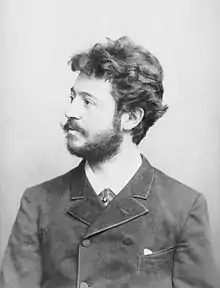Henri Petri
Henri Willem Petri (5 April 1856 – 7 April 1914) was a Dutch violinist, music pedagogue, composer and arranger.

Life
Born in Zeist, Petri came from a musical family. His father was hoboist in the urban orchestra of Utrecht, his cousin Willem Petri (1865-1950) was an organist, pianist and music pedagogue and another cousin Martinus Petri (1853-1924) was also a violinist and conductor. He received violin lessons within the family; after his father's death with the concertmaster Dahmen of the Utrechts Symfonie Orkest. From 1871 to 1874, he studied with Joseph Joachim in Berlin. Presumably, he subsequently studied with Henri Vieuxtemps at the Royal Conservatory of Brussels .[1][2]
In 1877, Petri gave a solo performance in London. Subsequently, from 1877 to 1881, he was concertmaster at the Fürstliche Hofkapelle Sondershausen and from 1881 to 1882 in Hanover. From October 1882, he was concertmaster of the famous Gewandhausorchester in Leipzig. He remained in this position until 1889; he then became Royal Saxon concertmaster (Königlich Sächsischer Konzertmeister) at the Dresdner Hofkapelle, (present-day Staatskapelle Dresden) as it was then called.[3]
In addition to being a concertmaster, he also taught at the Hochschule für Musik Carl Maria von Weber Dresden. Among his students were the conductor Willem Mengelberg, the composers Gustav Carl Luders, Margarethe Stern, Dora Pejačević, Arno Starck, and the violinist Franz Spiess.
Petri worked as a violinist in various chamber music ensembles. Together with Bolland, Thümer and Klengel (later A. Schröder) he formed the Gewandhaus Quartet in Leipzig. In Dresden, he founded his own "Petri Quartet" together with Erdmann Warwas (violin), Alfred Spitzner (viola) and Georg Wille (cello). There is a portrait of this string quartet painted in 1907 by Robert Sterl.
As an arranger he wrote a large number of arrangements for his instrument, the violin. As a composer he also wrote his own works. Petri became friends with the composer Ferruccio Busoni. He dedicated his second string quartet as well as the violin concerto whose premiere he gave in 1897 with the Berlin Philharmonic conducted by Busoni himself.[4]
His son Egon Petri (1881-1962) was a pianist.
Compositions
Songs
- 1884 Sechs Lieder, for voice and piano, op. 4
- Die Waise "Sie haben mich geheissen" - text: Adelbert von Chamisso
- Volkslied: "Hat dich ein blühendes Blümchen" - text: A. Träger
- Trost "Glücklich wer auf Gott vertraut" - text: August Heinrich Hoffmann von Fallersleben
- Neig' schöne Knospe - text: Mirzə Şəfi Vazeh
- Die Ablösung "In Schnee und Eis in kalter Nacht" - text: Robert Reinick
- Die Quelle "Uns're Quelle kommt in Schatten" - text: Adelbert von Chamisso
- 1884 Lieder - Lieder aus Williram, for voice and piano, op. 5 - text: E. Kühne
- Lied der Berthradis "Schlafe nur ein, mein Kind"
- Die Engel droben sind rein und schön
- Die Blume senkt das Köpfchen
- Ging ein munt'rer Vogelsteller
- Gute Nacht: "Im tiefsten Innern"
- Lieder, for voice and piano, op. 6
- Vergissmeinnicht: "Wild bewachs'ne Felsen" - text: A. von Tettau
- Tobe! tobe mein Herz - text: A. von Tettau
- Du bist so still, so sanft, so innig - text: Emmanuel Geibel
- Wie des Mondes Abbild zittert - text: Heinrich Heine
- Das Rosenband: "Im Frühlingsschatten" - text: Friedrich Gottlieb Klopstock
- Wiegenlied: Guten Abend, gute Nacht (after Johannes Brahms)
Chamber music
- 1884: Sechs kleine Stücke, for violin and piano, op. 1
- 1884: Albumblatt und Barcarole, for violin and piano, op. 2
- 1884: Drei Fantasiestücke, for violin and piano, op. 3
- 1900: Die hohe Schule des Violinspiels - Werke berühmter Meister des 17. u. 18. Jahrhunderts Bd. I, Nr. 1-7., for violin and piano
- 1910: Die hohe Schule des Violinspiels nr. 1, (Nr. 1-10), for violin and piano
- 1910: Die hohe Schule des Violinspiels nr. 2, (Nr. 11 - 20), for violin and piano
- 18 kleine Duette, for 2 violins
- Träumerei, for violin and piano - dedicated to Pauline Erdmannsdörfer-Eichtner
Work for violin
- 1885: Künstler-Etüden, for violin solo, op. 9
Further reading
- Gemälde, Zeichnungen, Briefe und Dokumente - Sonderausstellung zum 90. Todestag des Dirigenten Ernst von Schuch (1846–1914) und des Soloviolinisten Henri Petri (1856–1914), in Katalog der Ausstellung vom 1. Mai bis 18. Juli 2004 in Robert-Sterl-Haus Naundorf (Sachsen).
- Ferruccio Busoni: Briefe an Henri, Katharina und Egon Petri : Gesamtausgabe.[5] Wilhelmshaven Noetzel, 1999.
- Wilhelm Joseph von Wasielewski en Waldemar von Wasielewski: Die Violine und ihre Meister, 4th edition, Sändig, Wiesbaden 1904, p. 518.